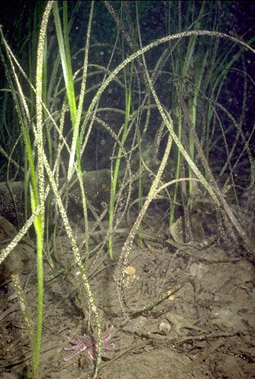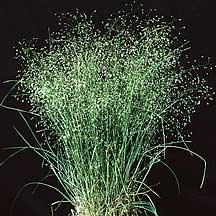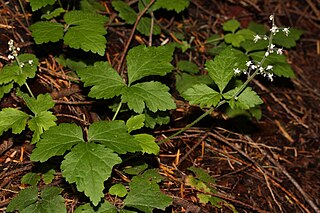
Zostera is a small genus of widely distributed seagrasses, commonly called marine eelgrass, or simply seagrass or eelgrass, and also known as seaweed by some fishermen and recreational boaters including yachtsmen. The genus Zostera contains 15 species.

Oryzopsis is a genus of Chinese and North American plants in the grass family. Species from this genus are commonly called ricegrass.

Festuca altaica, also known as the altai fescue, or the northern rough fescue, is a perennial bunchgrass with a wide native distribution in the Arctic, from central Asia to eastern North America. It was first described in 1829 by Carl Bernhard von Trinius. It is under the synonym F. scabrella, the rough fescue.

Phyllospadix scouleri, or Scouler's surfgrass, is a flowering marine plant in the family Zosteraceae. It is native to the coastline of western North America from the Alaskan panhandle to Baja California.

Tiarella trifoliata, the three-leaf foamflower, is a species of flowering plant in the family Saxifragaceae. The specific name trifoliata means "having three leaflets", a characteristic of two of the three recognized varieties. Also known as the laceflower or sugar-scoop, the species is found in shaded, moist woods in western North America.

Allium acuminatum, also known as the tapertip onion or Hooker's onion, is a species in the genus Allium native to North America.

Pyrrocoma is a genus of North American plants in the family Asteraceae. These wildflowers are sometimes known as goldenweeds.

Grayia spinosa is a species of the genus Grayia in the subfamily Chenopodioideae of the flowering plant family Amaranthaceae, which is known by the common names hop sage and spiny hop sage. It is widely distributed across the Western United States, where it grows in a number of desert and mountain habitats.

Carex rossii, commonly known as Ross's sedge, is a hardy species of sedge that is often a pioneer species in areas with little or no established vegetation, or in places where disturbance has occurred. Ross's sedge grows in a variety of habitats throughout much of western North America, from Alaska to Ontario, south to New Mexico and California. It flowers in May and June.

Thalassia testudinum, commonly known as turtlegrass, is a species of marine seagrass. It forms meadows in shallow sandy or muddy locations in the Caribbean Sea and the Gulf of Mexico. Turtle grass and other seagrasses form meadows which are important habitats and feeding grounds. The grass is eaten by turtles and herbivorous fish, supports many epiphytes, and provides habitat for juvenile fish and many invertebrate taxa.

Tofieldia is a small genus of flowering plants described as a genus in 1778. It is widespread across much of Europe, Asia, and North America.

Halodule uninervis is a species of seagrass in the family Cymodoceaceae. It is native to the western Pacific and Indian Oceans. Common names include narrowleaf seagrass in English and a'shab bahriya in Arabic.
Phyllospadix serrulatus is a species of aquatic plant in the Zosteraceae family. It is referred to by the common name toothed surfgrass, and is found along the shorelines of British Columbia and southern Alaska. It is also found in Oregon. It grows in salt marshes in the intertidal zone.
Phyllospadix iwatensis is a plant species found along the seacoasts of Japan, Korea, China, and the Russian Far East. It was first discovered in 1929 near on the Miyako Peninsula in Iwate Prefecture in Japan, in northeastern Honshu. It occurs in the intertidal zone along the shore.

Astragalus drummondii is a species of flowering plant in the legume family known by the common name Drummond's milkvetch. The botanist Thomas Drummond first identified the plant during his travels in North America from 1825 to 1835, the year of his death. Astragalus drummondii is one of many plants named after him. Upon the return of samples collected by Drummond to England, his findings were published in Sir William Hooker’s Flora Boreali-Americana in 1840.

Pleea is a small genus of flowering plants described as a genus in 1803. There is only one known species, Pleea tenuifolia, the rush featherling, native to the southeastern United States.

Smilax lasioneura, the Blue Ridge carrionflower, is a North American species of flowering plants in the greenbriar family. It is widespread across central Canada and the central United States, from Ontario, Manitoba and Saskatchewan south to Texas, Louisiana, and Florida.

Erigeron grandiflorus is a North American species of flowering plant in the family Asteraceae known by the common names Rocky Mountain alpine fleabane and largeflower fleabane.
Erigeron radicatus is a North American species of flowering plant in the family Asteraceae known by the common names Hooker's fleabane and taproot fleabane The species grows in central Canada and parts of the north-central United States, primarily the northern Rocky Mountains and the Black Hills. It has been found in Idaho, Montana, Utah, Wyoming, Colorado, Nebraska, and South Dakota, with a few isolated populations reported from North Dakota.

















